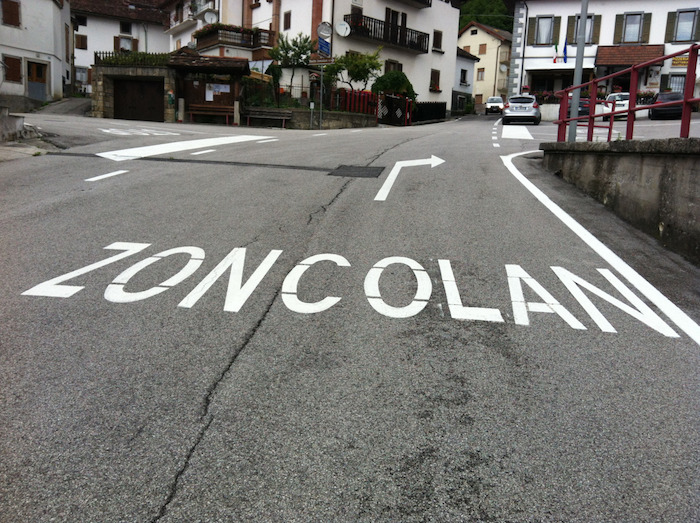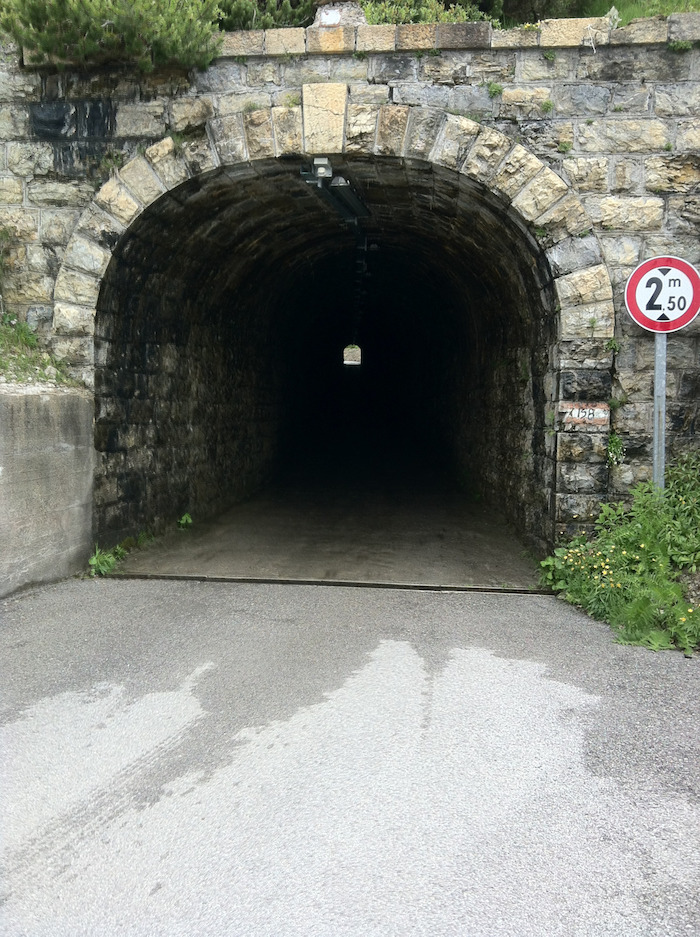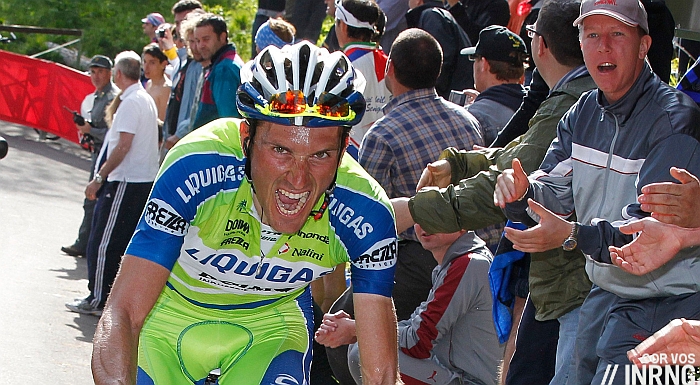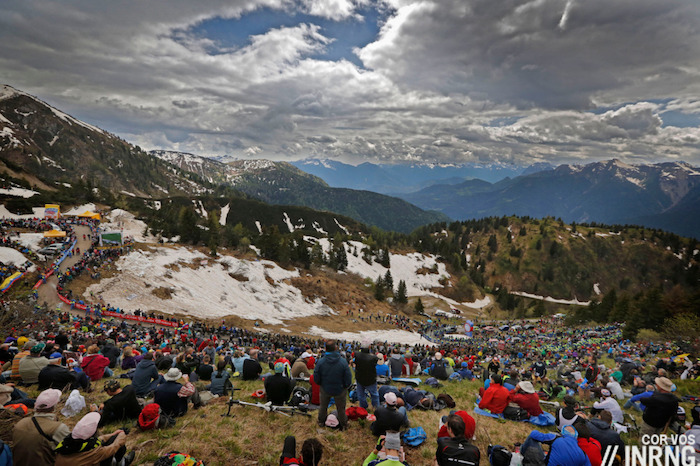For decades the Giro visited its classic climbs. For good reason as the Stelvio, Pordoi and Gavia are as difficult as they are beautiful. But it wasn’t enough for some and the hunt was on for new challenges and in 2003 the Giro tackled Monte Zoncolan.
Viewed from afar it’s just 10km long and only reaches 1,730m above sea level but it is one of the steepest roads in the sport and has quickly become one of the most feared climbs.
The Route: there are three ways to the top, two on the east where you can take the main road from Sutrio or the forest road from Priola. The Giro d’Italia has used the Sutrio road before but the third route, the western flank from Ovaro, seems to have become the settled choice for the Giro in recent years. From Ovaro It’s 10km long and climbs at an average of 12% which would be enough to make it an exceptional climb but it’s got sustained sections at 15% or more. It climbs to a ski area.

The Feel: it’s hard right from the start. Watch on TV and when the road starts climbing out of Ovaro the commentators will say the climb proper has yet to start but it certainly is climbing with double-digit percentages. A church sits by the road, its tower oddly built on the other side of the road, almost as if the bells should ring for anyone passing. You climb into the village of Liariis – named after a Danish directeur? – and the road flattens out. You must eat and drink here because later just taking a sip will affect breathing and balance.

As you leave the village, right by the exit sign the road rears up and it’s immediately 15,16 17%. The image above shows the exact point but the camera never captures the gradient. It’s tempting to get out of the saddle, the kind of response you’d use on the Mur de Huy but for a cheap comparison this is like eight Murs stacked one on top of the other. Stand up here and you probably won’t last. We take it for granted that the legs spin but you’re quickly reduced to concious “left, right, left, right” commands to the legs to push on, a series of leg-presses.
On TV the race climbs up so fast but the lone rider scales each long ramp in slow motion. The Mortirolo is a rival for difficulty but it’s packed with hairpins, intermediate goals to aim for and if it bites it rolls better. The Zoncolan has switchbacks too but progress between them seems so much slower.

There’s little shade once the sun is up. Tree stumps line the road, one for every for every pair of wooden legs. They felled the trees so when the Giro rode up they could have clear helicopter shots of the race. Now the sun gets a clear shot on you and with little breeze as you winch your self up at 8-10km/h it can be hot.
There are views but chances are all you’ll be looking for is the road and the easiest line up, riding past muddy sections where forestry work has dirtied the road, all that matters is the few metres of road in front. Lift your head if you can for the signs celebrating the sport’s famous climbers.
Hard? Yes and anyone who glances at the profile above may regret their haste. It’s not obvious from the illustration but there are sustained sections at 20%. Worse, when the slope eases to 14% you’re unlikely to have much left to respond, try to change up a gear will only leave you grinding although locals who climb more often will learn to use these sections to their advantage; any pro riding in the Giro would do well to visit the climb a couple of times. It’s this irregularity that makes it so hard, if it was 20% all the way you’d just borrow a mountain bike but the subtle changes in gradient tease the rider.

Near the summit and the road begins to open up with larger views but suddenly it turns into the mountain. Three short and damp tunnels arrive. By now the gradient has eased but it’s still 10% and too early to sprint for the top. It’s here that the climb changes. After slogging up a road that resembled a drainage gulley or the route of a bobsleigh course, suddenly the landscape opens up and the road zigzags through fields. When the Giro is here it makes for a natural theatre where spectators can stand in the stalls and watch the riders emerge from the tunnel below and slowly make their way to the line. Right at the top and there’s a sign and some rusting metal artwork to commemorate the climb. It’s no dead end summit finish, you can continue down the other side.
The Verdict: a relentless ramp where even the best climbers ascend at 7-8km/h an hour. It’s hard but not searingly painful, a grinding slow-mo effort that is tiresome but as it takes so long it lacks the acid bath intensity of, say, the Mur de Huy. The Zoncolan strips away the need for technical skills, reducing the rider to Sisyphus-like creature forced to roll the pedals one by one. Some climbs can be joyful as you ascend through scenes from a postcard or pass legendary places but the Zoncolan reduces cycling to winching. Climb it and say you’ve done it.

It’s so steep that:
- Team cars are not allowed up, mechanics accompany their riders on the back of a motorbike
- When Mario Cipollini arrived at the foot of the climb in 2003 he switched to a mountain bike
- it’s become a reference, such that when a new climb appears in a stage race it is often compared: “is it as steep as the Zoncolan?”
But hold on… this is how myths spread. It’s neither too steep nor are the tunnels at the top to small for a team car; it’s just motorbikes are used as they take up less space. As for Cipollini, he quit the race and never got to the climb although he and his team did have an MTB prepped which says more about stuntman than the climb, he wanted attention on a day for himself and his bike sponsor when he’d otherwise be forgotten. The Zoncolan is hard but it has its rivals, the nearby Crostis, the Mortirolo, the Angliru and so on although its name does stand as a reference.

History: ladies first: the Giro Donne was the first race to visit in 1997 and Fabiana Luperini won. If this put the climb on the map it wasn’t until 2003 that the men arrived. Even taking the “easy” side from Sutrio made an impression and it’s been included five times in the race. It appeared under Angelo Zomegnan’s reign as Giro director, a time when “Zom” sadistically took the race to new places in search of spectacle, staging the race for TV. If the Giro couldn’t be the biggest race then making it the hardest or scariest contest was as good, if not better. But this brought a kind of spectacle inflation and the more they searched for wild climb the more it devalued existing giants like the Stelvio or Pordoi and what were once the hardest climbs of Italy became relatively humdrum.
As for the Zoncolan itself, the spectacle has been mixed, in 2010 Ivan Basso dropped Cadel Evans, a decisive moment in the race as Basso’s pacific face became a snarling rictus of rage. But it’s so steep that wild attacks are impossible and 2014 merely saw Nairo Quintana mark his rivals.

The Zoncolan Paradox: the climb is so hard it can prevent racing. It takes such an effort to accelerate that the wise idea is to measure your effort rather than trade blows. Go into oxygen debt here and the you’ll never make the repayments on the 20% gradient. It means everyone’s locked in a private fight against gravity rather than their rivals, an expression of W/kg rather than flair. This linear style is a sensible approach but doesn’t make for good TV.
The slope that launched a thousand chainsets: look back at old footage of Eddy Merckx and others and they rocked their shoulders when climbing. With old six or seven speed bikes racers didn’t get gears much lower than 39×23 so when the road reared up they were left grinding, each pedal stroke a leg press. Today’s riders sit steady, largely thanks to improved gearing, and they can spin up the steepest of summits. So when the Giro arrived on the Zoncolan gears were needed to prevent a retro drama. It coincided with production of compact chainsets and some teams were quick to fit them, 34×28 is common for a pro on here, 36×32 too. Many cycle industry trends rely on mimicry and the pros’ use of compacts gave legitimacy to smaller gears and sales have since flourished.
Gearing: Snobs might think sprockets with more teeth than a circular saw blade looks amateurish but they’ll be the ones looking bad when they’re forced to walk up. If you’re visiting the nearby Dolomites and have opted for low gears you’ll need to go much lower again. For comparison a pro in the Giro uses 39×25 for a mountain stage but they’ll opt for 34×28 here, a gear that’s roughly 25% shorter. It’s expensive and awkward to change gears but the Zoncolan is steeper on a totally different scale so at least be warned if you don’t come prepared. If you’re stubborn and in the Dolomites for a trip then save Zoncolan for last so any resulting knee injury doesn’t ruin the rest of the trip.
Travel and Access: tucked in the north-eastern corner of Italy, the Zoncolan nestles in the mountains. Cities in the plains like Venice, Padova, Trentino and Trieste offer major transport connections but sit far from the mountains. Udine, capital of the Friuli region, makes a better base.
The Zoncolan also sits close to Austria and Slovenia. Indeed Slovenian capital Ljubljana is not far away, if you wanted to check out some Slovenian climbs then the Zoncolan is only a short trip into Italy.
Photo credits: Cor Vos and RCS Sport plus thanks to reader Kelly S for the rest of the images, he took a camera to record the road, a generous effort.
More roads to ride at inrng.com/roads


Great all-around analysis (as usual).
Brilliant Riis pun.
Super write up. Will you do the Rettenbachferner as part of your excellent series? In terms of length and gradient it’s similar to the Zoncolan but it starts at something like 1500m before finishing not that far shy of 3000m, so you have the altitude to add to the mix too.
Well that’s put me off it 😉
I’ve heard of it and would like to visit Austria for several climbs, this would on the list.
Never mind 34×28, I think I’d have trouble getting up it on a 28×34, especially as I’m currently carrying more timber than Betancur.
i feel tired just thinking about that climb
Great piece!
Have you ridden the Priola side yourself? If so, do you think it’s the hardest of the three?
Just up this side and down to Sutrio. You can see the road to Priola and it joins the Sutrio road on the way up. It didn’t look worse but people do say it’s the hardest version, but is this because it’s been a forest road and therefore always a bit rougher or is it steeper?
I haven’t done either myself (nor do I think I would be able to), so I asked because I have heard the same thing. Based on the two profiles, the Priola side is steeper (or just super steep for longer), but it has a little less vertical gain. I think you’d have to ride them both to judge it though, as irregularity is sometimes hard to judge on a profile. After a quick glance on Google Maps it does seem like the surface is rougher in the forest. (Priola profile: http://profils.cols-cyclisme.com/1603.gif)
I think it was part of the double Zoncolan rumours for last year’s Giro, I don’t know if it was for logistic reasons that it was dropped, but they would have to descend the Sutrio side and I guess after the cancellation of Crostis they wanted to play it safe.
INRNG, worthy of Krabbé.
Is the Cipo story from 2003 apocryphal? According to the Cycling News archives, Cipo was a non-starter on Stage 12 that summited Zoncolan.
* http://autobus.cyclingnews.com/road/2003/giro03/?id=results/livecomp12
* http://autobus.cyclingnews.com/road/2003/giro03/?id=results/stage12
Yes, seems he bailed out of the stage but he and the team had an MTB ready for the climb.
I think Cipo might have considered going up it in a ski lift.
I doubt he ever intended getting out of bed for the Zoncolan
Compact gearing has been great for the road market. Their legitimization abd adoption on most oem builds makes the bikes so much more useful and accessible, and i still regularly get requests to fit 11-36 cassettes on compact drivetrains.
Great writeup ! It seems like the climb might have been more “enjoyable” before the giro rolled through and cut the trees.
Excellent review. We rode this last year at the Giro. Never again. I would never do this on any other day as it’s far worse than the Mortirolo. Without the crowds and great atmosphere of climbing up into this natural amphitheater to see the pros, I would never have made it. Compact might be OK, but for me a triple with 30 – 29 low gear was barely enough! I’m very glad I went and rode it, but I’ll never return. Same with Mortirolo, though we’ll still take clients over it, but I’ll be driving the van!
I agree with that. There are some climbs that are beautiful to ride up, and then you have those like the Mortirolo and Zoncolan which are pure slogs. It’s an achievement for sure, but crawling up incredibly slowly whilst suffering like a dog is not much fun. Once is enough 🙂
I was on the mountain roadside, Larry – I might have been cheering you on, in fact 🙂
Seriously, I have nothing but respect for amateurs who ride that climb.
Sam- Or perhaps you watched me try to get my tongue out of my front wheel?
http://cycleitalia.blogspot.it/2014/06/giro-ditalia-monte-zoncolan-part-2-we.html
Once was plenty! I’ll watch on TV from now on, knowing how amazingly tough this was. Where is Zomegnan now when the Giro needs him? Oh yeah, right, I forgot. Replaced with Mr. Facebook who was in charge when all the euros went missing…and now we have guys who try, but aren’t the passionate dictator RCS needs so badly. Vincenzo Torriani must be doing 90 rpm in his grave. W Il Giro!
“it’s hard right from the start”
Brilliant, just brilliant. And thanks.
That was me. Sorry.
Thank you! Great article and wonderful timing: Just yesterday evening I was looking it up on strava.
“the camera never captures the gradient”
What I learned in photography school: If you want to show the gradient, you have to level the camera. You will need a very wide angle lens (or a “large format” camera), and a spirit level. Set up the camera so it is exactly vertical. Then the brain will get the message about the steepness when looking at the picture. The more you point the camera up, the less steep it will appear in the resulting photo.
Even with those tricks photos and TV don’t do these things justice. The best indicator for Zoncolan other than riding it yourself is how unpro the pros (who are trying to race up) look going up this thing. The ones fooling around with wheelies and such make it look too easy and perhaps at an “avoid the time cut” pace for them it’s not so hard? I’m happy that compact chainsets and those monster rear cogs have become acceptable to the masses. We call ’em the “vanity triple” as they avoid the stigma of that 3rd chainring so many fear. I dislike the huge gaps between 34 and 50 so I’ll suffer the stigma with my 30-42-52 while enjoying smaller gaps between ratios…though only a Vivax motor will ever get me up the Zoncolan again!
I’m doing fine with a triple myself. I couldn’t care what people are saying, once the road points really upwards, my legs feel the difference. Haven’t been on the Zoncolan (yet) though 😉
Too bad about the trees, or is that just the Canadian in me?
A lot of the mountain looked like managed forestry, if they cleared the sides of the roads, the rest is seemed to get felled and replanted.
Thanks, great article as usual, though I doubt I’ll ever tackle this one. Call it peddling squares mentally.
“You climb into the village of Liariis – named after a Danish directeur?”
Got to be Inrng’s quote of the year so far – top work!
Agree totally with that!
Fantastic article, and took me straight back to my climb of it in May 2014 at the Giro.
About 10 kilometers before the climb I started feeling sick at the thought of what I was to encounter! The wall of Tarmac that welcomes you is incredible, and unlike other mountain climbs the hairpins don’t give you any respite, they are actually steeper!
I went up it ok-ish, staying seated while muscling to keep the front wheel on the ground with every pedal stroke. I have never seen bikes just fall down in front of you, riders to fatigued to continue and unable to unclip.
I received a big black toe nail on my left foot from the effort, and since it came off it has been distorted, so I have a souvenir of Zoncolan as a constant reminder.
Great story again, cheers
Back in the day, the tunnel at the top was dirt, muddy and heavily crowned. It was all one could do to keep going uphill in the dark without sliding to one side or the other. BTW, I asked Ivan Basso which climb he considered harder, the Zoncolan or the Mortirolo. He told me the Mortiorolo because even though the Zoncolan was steeper he could keep a steady rhythm and just pedal up it. He said the ‘stair-steppy’ nature of the Motirolo made it harder to find a good rhythm.
Before we get into another debate about which is harder, remember that Basso is an elite athlete and not a mere mortal like the rest of us.
Re Zoncolan v Mortirolo, comparisons are normally tricky, but I found the Zoncolan to be in a different category. I rode the Mortirolo (same trip, same gearing, no star-trekking) and personally wondered what the fuss was all about.
But some rate the Angliru as harder still, so I rode that in Sept ’14 to compare.
Short vid here if interested in that one https://www.youtube.com/watch?v=jbmeymAooY0
Why do we have these ridiculously steep climbs in Italy and Spain but not – for the most part – in France? Is it really down to the Napoleonic / military stories that one hears about?
Partially yes, there’s a law that decrees all roads have to be built at 12% or less. But there are many roads steeper than this, if they wanted to there are plenty of steep roads to race up that could rival the Giro or Vuelta, even with off-road sections too. Just as the Zoncolan is really a forest route that’s been paved to help make a ski area, there are forest and fire roads available in France. The Tour’s become a victim of its success and sticks to the large roads to accommodate the media and caravan, although it too is starting to explore more roads.
As good ol’ Titus Livius wrote, “pleraque Alpium ab Italia sicut breuiora ita arrectiora sunt” 😉
loved this piece. when do the mountain open for riding?
Big question, some roads are open all year to get tourists to the ski resorts but otherwise, see the Giro which won’t attempt the Alps until as late as possible in May. Better to wait for things to thaw and go in late June onwards.
For Italy late June is reliably good as is July. Skip August as everyone and his fratello is up there escaping the heat. Early to mid-September can be good too….after that you’re taking the same gamble that you do in May or early June.